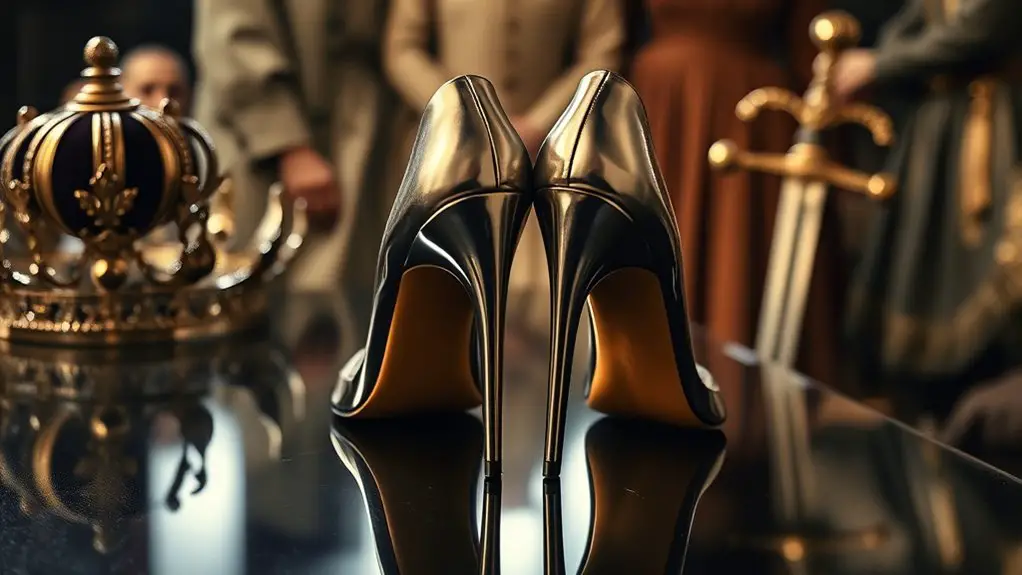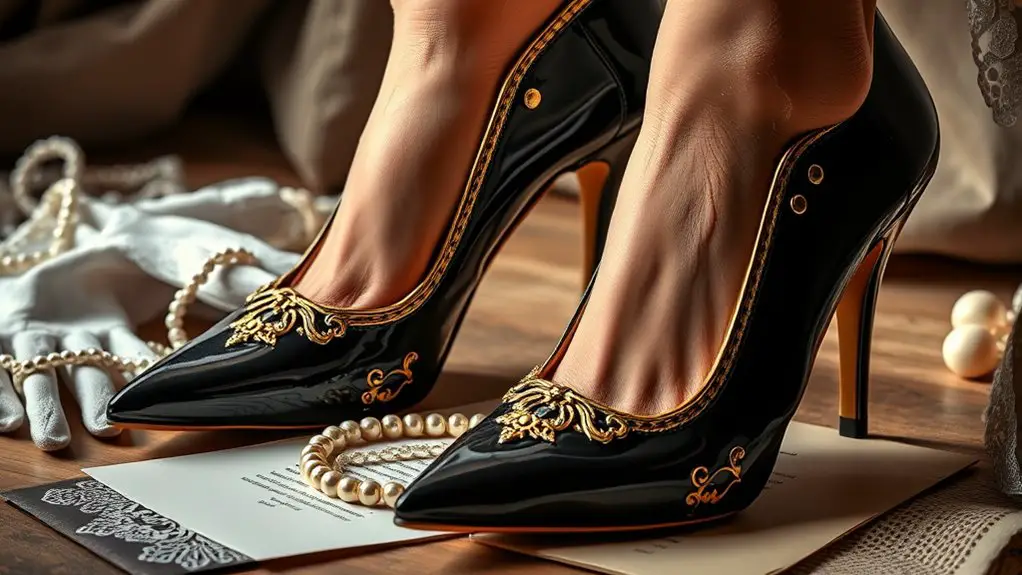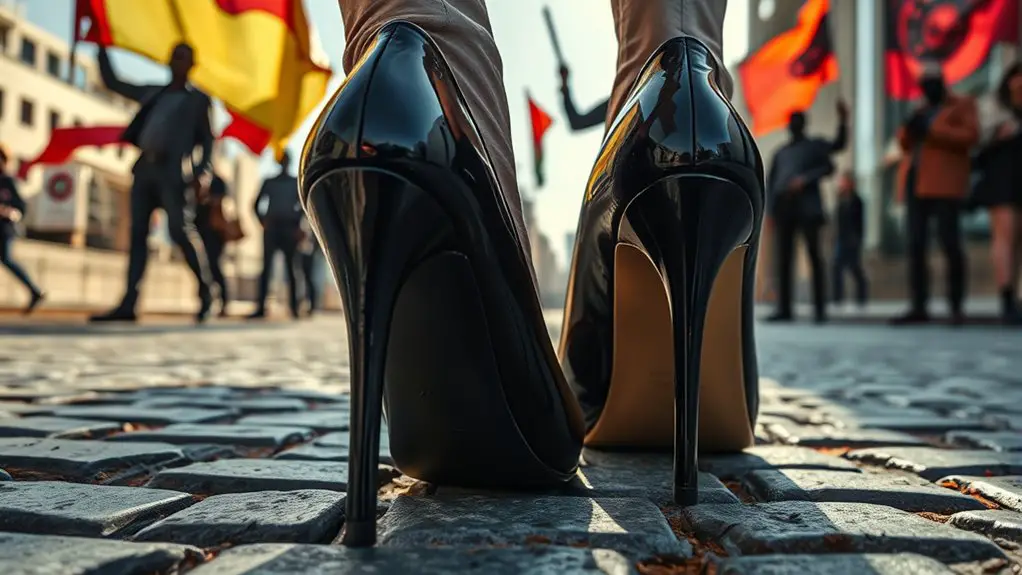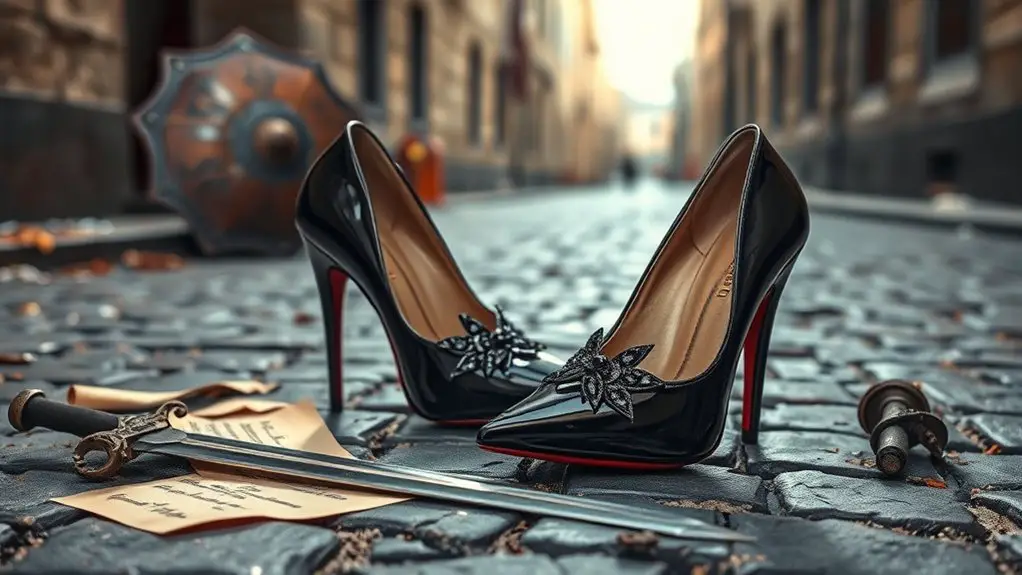High heels have long been more than just fashion statements; they’ve served as practical weapons throughout history. Originally designed for stability, they evolved into tools for self-defense. Women used the sharp points to inflict pain or assert dominance in confrontational settings. In political turmoil, these elevated shoes became symbols of strength and rebellion. Their dual purpose of fashion and function showcases a complex narrative of empowerment. There’s much more to uncover about their intriguing history and cultural significance.
The Origins of High Heels: A Symbol of Power

High heels have long embodied a complex interplay between power and femininity, tracing their origins back to the 10th century when Persian cavalrymen donned elevated footwear to secure their stance in stirrups. This initial purpose reveals high heels’ cultural significance, as they were symbols of status and military prowess. As you explore their evolution, consider how this footwear transcended practicality to become a potent symbol of authority.
The psychological impact of high heels cannot be understated. By elevating the wearer physically, they also enhance one’s perceived dominance and confidence. When you slip on a pair, you might feel an immediate shift in your demeanor, embodying strength often associated with leadership. Throughout history, the elevation of women in society has paralleled the rise of high heels, making them not just a fashion choice but a beacon of empowerment—conveying that power can be both feminine and formidable.
High Heels in the Renaissance: Fashion Meets Function
In the Renaissance, high heels weren’t just a fashion statement; they served a practical purpose too. You’d find that these elevated shoes were designed not only to enhance stature but also to act as defensive tools in a turbulent time. As you explore this era, you’ll see how style and function intertwined, creating a unique dynamic in footwear.
Renaissance Fashion Trends
While many view high heels as mere fashion statements today, during the Renaissance, they served a dual purpose that blended style with practicality. Renaissance footwear was characterized by elaborate designs, and heels became a symbol of status. They helped elevate wearers, literally and figuratively, enhancing their presence in courtly settings. However, these elevated shoes weren’t just about aesthetics; they provided a fashionable practicality. The design allowed for better posture, which was essential for displaying the ornate garments of the time. As you walked the cobblestone streets or attended lavish gatherings, high heels reflected societal values and the intricate balance between beauty and utility. Consequently, they were not merely accessories but integral to the fashion landscape of the Renaissance.
Heels as Defensive Tools
During the Renaissance, the multifaceted role of high heels extended beyond mere fashion, as they also emerged as unexpected defensive tools. Women, often seen as vulnerable, adapted their footwear into practical implements for self-defense. In a society rife with political intrigue, high heels became an essential part of their defensive techniques.
- Sharp heels could be used to inflict pain during heel combat.
- The elevation provided better balance and agility in confrontations.
- High heels made it easier to navigate uneven terrain while escaping danger.
- They served as a statement of power, allowing wearers to assert dominance.
This dual purpose of high heels blurred the line between style and self-preservation, showcasing how fashion could serve practical needs in tumultuous times.
The Role of High Heels in Courtly Intrigue

When you think about high heels in the context of courtly intrigue, it’s clear they were more than just a fashion statement; they were tools of power. Worn by the elite, these elevated shoes symbolized status while also serving as a strategic advantage in the subtle games of influence. In the hidden corridors of palaces, their click could signal both confidence and cunning, shaping the dance of political maneuvering.
Fashion as Power Play
High heels, often seen as mere fashion statements, have historically served as potent symbols of power and influence, particularly within the confines of royal courts. In these environments, the height of your heel could dictate your standing in the intricate web of power dynamics.
- They emphasized status and authority.
- High heels became tools for fashion rebellion against traditional norms.
- Wearing them often reflected one’s alignment with or opposition to prevailing courtly expectations.
- The audacious choice of heels could shift the course of social interactions.
Symbol of Status
As the intricate dance of courtly life unfolded, the height of one’s heels often served as a silent yet powerful communicator of status and ambition. In a world where societal expectations dictated elegance and power, those who could afford towering heels showcased their refinement. It wasn’t just about aesthetics; it was a strategic move in the game of influence.
| Heel Height | Symbolism |
|---|---|
| Low (1-2 in) | Modesty and humility |
| Medium (2-4 in) | Rising status |
| High (4-6 in) | Authority and prestige |
| Very High (6+) | Unattainable elitism |
Navigating these societal norms, you’d realize that high heels were more than footwear; they were a declaration of one’s place in the hierarchy.
Secretive Courtroom Tactics
Though often overlooked, the strategic use of high heels in courtrooms throughout history reveals a fascinating layer of intrigue and psychological warfare. High heels serve as tactical footwear that can shift courtroom drama in subtle yet powerful ways.
- They elevate the wearer’s stature, creating an imposing presence.
- The sound of heels clicking on the floor commands attention, heightening tension.
- Their design can project confidence and authority, influencing jury perceptions.
- High heels can also become a symbol of femininity and power, deliberately used to challenge stereotypes.
In these high-stakes environments, every detail matters. The choice to wear high heels demonstrates how fashion can play a role in legal strategy, turning a seemingly innocuous accessory into a weapon of influence.
High Heels as Tools of Protest

While many associate high heels with glamour and fashion, they’ve also served as powerful symbols of protest throughout history. You might not realize it, but these shoes can be more than just stylish; they can convey a strong message. During various social movements, high heels have transformed into protest footwear, representing defiance against oppressive norms. Think of the boldness it takes to wear heels in a demonstration; it’s not just about aesthetics—it’s an empowerment declaration.
In recent years, activists have donned high heels to draw attention to issues like gender inequality and violence against women. By choosing such striking footwear, they challenge societal expectations and make their voices heard. The click of heels on pavement can echo through a crowd, symbolizing strength and resilience. In these moments, high heels transcend their typical associations, becoming a tool for change and a reflection of the power of personal expression in activism.
The Feminist Movement and the Empowerment of Heels
Empowerment often takes unexpected forms, and high heels have played a surprising role in the feminist movement. You might think of heels as merely a fashion statement, but they also symbolize empowerment in various ways. When embraced by feminists, high heels challenge traditional gender norms and assert a woman’s right to choose how she presents herself.
- High heels as a statement of confidence
- The evolution of feminist fashion incorporating heels
- Heels representing defiance against societal expectations
- The duality of heels as both empowering and objectifying
Through these lenses, heels become more than mere footwear; they embody empowerment symbolism. By reclaiming this accessory, women assert their individuality and strength. In a world that often tries to define femininity, high heels allow for a personal narrative that embraces both power and style, reflecting the diverse expressions of the feminist movement.
High Heels in Self-Defense: A Hidden Weapon
High heels can be surprisingly effective in self-defense, transforming a stylish accessory into a potential weapon. When faced with a threat, many might not consider their footwear, but high heels offer hidden advantages that can be utilized in self-defense techniques. The sharp heel can serve as an impromptu striking tool, targeting sensitive areas of an assailant’s body.
Imagine walking through a dimly lit parking lot, and suddenly you feel uneasy. Instead of panicking, you can leverage your heels. With a swift, calculated move, a well-placed kick can create distance between you and your attacker.
Moreover, the heightened position that heels provide can enhance your visibility, making it easier to spot potential dangers. While it’s essential to focus on traditional self-defense strategies, acknowledging the power of high heels can empower you in unexpected situations. They’re not just for fashion; they’re a tool for self-protection.
Cultural Variations: How Different Societies Utilize Heels
As different cultures have evolved, so too have the meanings and uses of high heels, revealing a rich tapestry of significance that goes far beyond mere fashion. In various societies, high heels embody distinct cultural significance and serve different purposes:
- Status Symbols: In many Western cultures, heels represent affluence and sophistication.
- Ritualistic Elements: In some indigenous communities, elevated footwear is used in traditional ceremonies to symbolize authority or connection to the spiritual domain.
- Expression of Identity: In fashion-forward societies, heels often reflect personal style and assert individuality.
- Functional Use: In certain Asian cultures, specific heel types may be worn for practical reasons, such as enhancing posture during performances.
These global variations highlight how high heels can transcend their role as mere fashion items, acting as powerful symbols of identity, tradition, and societal values within different cultural contexts.
High Heels in Modern Activism: Stepping Up for Change
Throughout history, the symbolism of high heels has shifted dramatically, and today, they’ve found a new role in modern activism. You might not realize it, but these once solely fashion-forward items have become powerful activism footwear. As you step into protests, you’re not just making a style statement; you’re joining a movement. High heels have emerged as a bold symbol in protest fashion, challenging societal norms and expectations.
Activists wear them to assert femininity and strength, flipping the script on traditional perceptions. During marches, heels clack against pavement, echoing determination and resilience. You can see this trend in events like the “Walk a Mile in Her Shoes” campaign, where men don heels to raise awareness about gender-based violence. Each step taken in high heels conveys a message of solidarity, proving that even the most unexpected items can serve as weapons for change in the fight for equality and justice.
The Future of High Heels: From Fashion Statement to Symbol of Strength
While many might still view high heels as mere fashion accessories, their evolution into symbols of strength and empowerment is undeniable. You’ll notice how society is reshaping heel symbolism, transforming these once-controversial shoes into instruments of empowerment messages. As you step into the future, consider these shifts:
- High heels in professional settings, asserting authority and confidence
- Designers crafting styles that prioritize comfort without sacrificing elegance
- Social movements embracing heels as a statement against oppression
- Celebrities using high heels to amplify their voices for change
This cultural shift signals a departure from traditional views, making high heels a powerful statement of resilience. Each pair now embodies a narrative of strength, reflecting a broader societal change where women (and men) use fashion to challenge norms. So, the next time you slip on those heels, remember—you’re not just making a statement; you’re stepping into a legacy of empowerment.
Frequently Asked Questions
What Materials Were Used to Make Early High Heels?
Early high heels were crafted from wood for its sturdy craftsmanship and leather for its durability. This combination not only provided support but also allowed for intricate designs that reflected the fashion sensibilities of their time.
How Did High Heels Evolve Over Different Cultures?
You’ll find high heels evolved considerably across cultures, reflecting their cultural significance. From status symbols in Europe to practical footwear in Asia, their fashion evolution reveals society’s changing norms and values, intertwining aesthetics with identity.
Are There Historical Records of High Heels Causing Injuries?
You’ll find historical incidents documenting high heel injuries, where their sharp edges and height caused accidents or even became tools of aggression. These examples illustrate the unforeseen consequences of fashion, blending beauty with potential harm across centuries.
What Are Modern Perceptions of High Heels as Weapons?
When you slip on those high heels, do you realize their dual purpose? In today’s world, social media amplifies their allure as fashion statements, yet they can also evoke a sense of empowerment and potential danger.
How Do High Heels Affect Posture and Movement in Combat?
High heels can create balance challenges, altering your posture and making it harder to move swiftly. This can lead to mobility limitations in combat situations, impacting your ability to react effectively and maintain stability.



